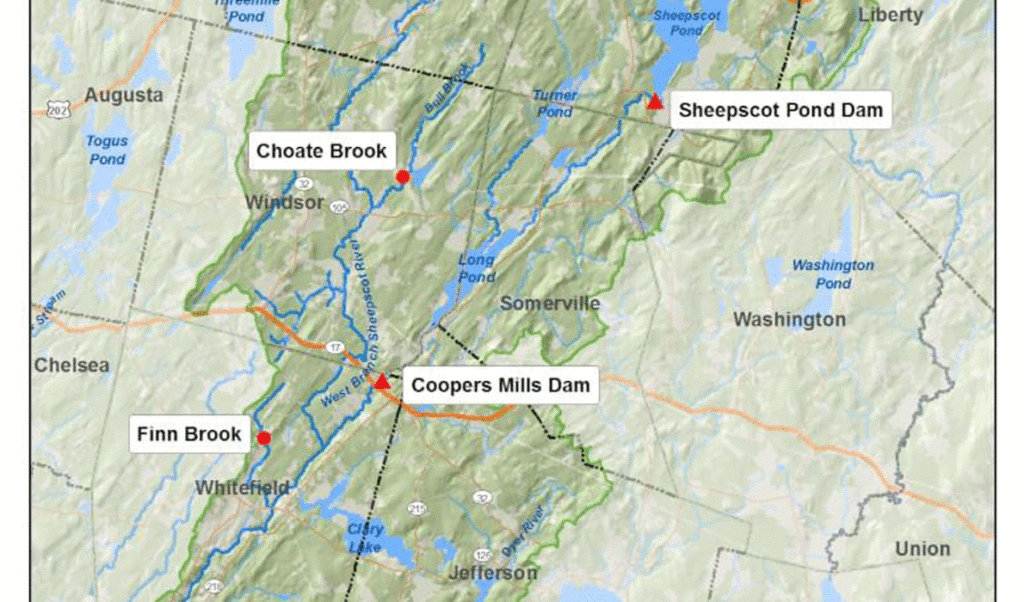By Catherine Schmitt
There is a break in the ragged Maine coastline between Seguin Island Light and Damariscove, a widening where the Atlantic Ocean floods into a rock-ledged bay, and through a complicated network of glacial-scoured back rivers, side channels, and islands. As the tide turns and the wind shifts, birds fly up and down the bay—kingfisher and cormorant, geese and gulls. Eiders, loons, guillemots, and seals float the waves.
High tide. The ocean pushes farther inland, where the bay becomes an estuary of winding marsh creeks, ancient oyster beds, and reversing falls.
Farther still and the estuary becomes a river, hemmed by forest and field. Saltwater reaches its limit but the sea carries on in the bodies of migratory fish, including alewives, through Class III rapids to Branch Pond in Palermo and Sheepscot Pond. Beyond, all is freshwater stream, to the Sheepscot River’s beginning at hillside springs in Montville.
The tide ebbs, the river picks up flow from the Kennebec, Sasanoa, and Montsweag rivers, flowing fast, parallel to bedrock layers. Above Sheepscot Falls, the tide will continue to ebb fortwo hours after the tide has turned again. It is a confusing, spectacular mix of land and seascape in a relatively small area, 58 miles in all. Sheepscot, in the language of the indigenous people, is the place where the river divides into many channels.
Along the low-tide shore, semi-palmated plovers forage in the rockweed, herons fish in tidal pools, periwinkles graze the rocks.
Flounder and lobster, tomcod, dogfish, Atlantic and shortnose sturgeon cruise the river bottom.
Are cod still present? Once they spawned in the Sheepscot in both spring and fall, part of a population extending to Ipswich Bay in Massachusetts. Menhaden, mackerel, and herring make seasonal appearances.
More than 150 species of birds and 26 species of marine mammals have been reported to occur in or near Sheepscot Bay.
Upriver, restoration efforts and community attention over the last few decades have preserved an intact corridor of fresh, brackish, and salt marshes that are home to nesting bald eagles, several rare plant species, the rare brook floater mussel, and salt marsh sparrows.
Endangered Atlantic salmon swim in the Sheepscot still, their passage lately made easier by removal of the dam at Coopers Mills. Smelt and striped bass are common residents. Largemouth bass, smallmouth bass, and brown trout have been introduced to the watershed and are well established.
The state has designated the Sheepscot “an area of ecological significance” for its variety of habitats, and “an outstanding river segment” because its “unparalleled natural and recreational values” provide irreplaceable social and economic benefits to people.
Despite being one of the smaller rivers in Maine, the Sheepscot has been studied over the years by the U.S. Fish and Wildlife Service, the Harvard University Graduate School of Design, the Atlantic Salmon Commission, and various other state agencies in association with Maine Yankee Nuclear Power Plant and Casco Bay oil terminals.
Much of the watershed has the state’s highest classification for water quality (AA and A); however, according to a watershed management plan prepared in 2007, there are signs of degradation such as low oxygen and increased bacteria levels. Roads, pavement, and buildings associated with changing development patterns are the greatest threats. The latest monitoring data suggest continued impairment from runoff and bacteria at Alna and below Halls Corner.
Local organizations have taken over stewardship and study, such as the Sheepscot Wellspring Land Alliance, Damariscotta Lake Watershed Association, and Hidden Valley Nature Center, which merged with Sheepscot Valley Conservation Association (which had previously merged with Sheepscot River Watershed Council) to form the Midcoast Conservancy. Much of the watershed remains a rural scene of hill, valley, and historic structures.
“The Sheepscot watershed communities are fortunate. Their region is still one of the most beautiful in Maine,” wrote the Harvard assessment team in 1974. It’s still true.
It was the Sheepscot, after all, that inspired poet Edward Arlington Robinson and science writer Rachel Carson.
“Contemplating the teeming life of the shore, we have an uneasy sense of the communication of some universal truth that lies just beyond our grasp,” wrote Carson. Nowhere is the universal truth closer to our comprehension than in the Sheepscot.
Catherine Schmitt is communications director for Maine Sea Grant at the University of Maine, and is author of The President’s Salmon.





